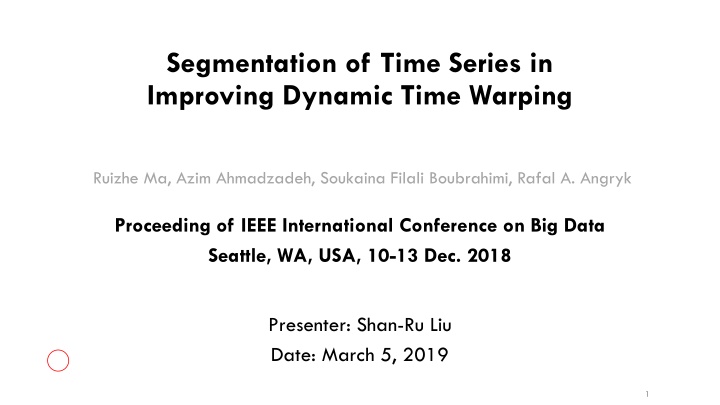
Improving Dynamic Time Warping Through Time Series Segmentation
Explore how segmentation of time series at significant feature points can enhance Dynamic Time Warping effectiveness by mitigating pathological warping paths. This study investigates the impact of different peak identification parameters on DTW and demonstrates the benefits of segmentation in sequence comparison.
Download Presentation

Please find below an Image/Link to download the presentation.
The content on the website is provided AS IS for your information and personal use only. It may not be sold, licensed, or shared on other websites without obtaining consent from the author. If you encounter any issues during the download, it is possible that the publisher has removed the file from their server.
You are allowed to download the files provided on this website for personal or commercial use, subject to the condition that they are used lawfully. All files are the property of their respective owners.
The content on the website is provided AS IS for your information and personal use only. It may not be sold, licensed, or shared on other websites without obtaining consent from the author.
E N D
Presentation Transcript
Segmentation of Time Series in Improving Dynamic Time Warping Ruizhe Ma, Azim Ahmadzadeh, Soukaina Filali Boubrahimi, Rafal A. Angryk Proceeding of IEEE International Conference on Big Data Seattle, WA, USA, 10-13 Dec. 2018 Presenter: Shan-Ru Liu Date: March 5, 2019 1
Abstract (1/2) Since its introduction to the computer science community, the Dynamic Time Warping (DTW) algorithm has demonstrated good performance with time series data. While this elastic measure is known for its effectiveness with time series sequence comparisons, the possibility of pathological warping paths weakens the algorithms potential considerably. Techniques centering mappings or lowering data dimensions such as windowing, slope weighting, step pattern, and approximation have been proposed over the years to reduce the possibility of pathological warping paths with Dynamic Time Warping. However, because the current DTW improvement techniques are mostly global methods, they are either limited in effect or limit the warping path excessively. on pruning off impossible 2
Abstract (2/2) We believe segmenting time series at significant feature points will alleviate some of the pathological warpings, and at the same time allowing us to obtain more intuitive warpings. Our heuristic approaches the problem from the human perspective of sequence comparison: by identifying global similarity before local similarities. We use easily identifiable peaks as the significant feature. The final distance is the DTW distance sum of all segments of time series. In this paper, we explore the impact of different peak identification parameters on Dynamic Time Warping and demonstrate how segmentation can help to avoid pathological warpings. 3
DTW 1. Global Warping Constraints: Sakoe-Chiba band, Itakura parallelogram 2. Lower Bounding: LB_Kim, LB_Yi, LB_Keogh 5
Q1: the first quartile M: median Q3: the third quartile Results (1/3) 8
Q1: the first quartile M: median Q3: the third quartile Results (3/3) 10
